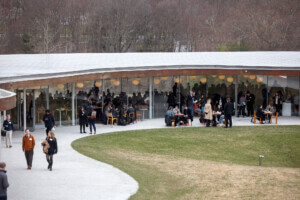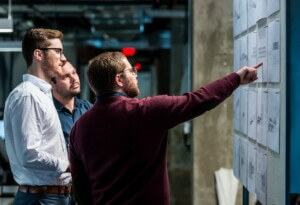Architects and engineers do not make buildings. We translate spatial needs into instructions for construction in the form of drawings and specifications. Depending on the size of a project, these instructions can result in tens if not hundreds of thousands of actions.
If we see architectural design not as envisioning future space but as defining a series of instructions for future actions, we ought to be able to examine these strings of actions beforehand and reduce the amount of harm they may cause. The activities we prescribe typically involve the use of energy to relocate material—assemblies of atoms—from one location on this planet to another. Laborers arrange them into a temporary constellation, which we might call a building or a city.
As architects, then, we organize energy and materials. Some of this energy might be forcibly extracted from humans, i.e., slavery, which none of us want. Automation is one way to avoid this outcome, because using robots rather than humans minimizes the risk of exploitation. (This assumes that the energy and material needed to create and power the robots are ethically obtained.) However, I propose another way that would still allow humans some input in the construction process while also lessening the sting of exploitation.
We can begin by looking at supply chains. The more complex and global a chain is, the greater the risk of discovering modern slave labor. As I see it, the problem lies with our current notion of supply, which narrowly describes linear material flows. But what if we were to reconceive supply in terms of circularity? Changing the way we source materials—away from mining the planet toward mining the built environment—would eliminate extraction, processing, and shipping at the top of supply chains, where forced labor is the most prevalent.
Circularity offers obvious environmental advantages. Apart from thwarting the depletion of natural resources, reaching a material recycling rate of 85 percent across our economy would reduce CO2 emissions by up to 50 billion tons, the equivalent of taking 10 billion cars off our roads. Applying this same lens to labor yields even more benefits. For example, mining existing buildings close to home for materials allows more control over labor conditions and strengthens local economies. One calculation estimates that every 10,000 tons of recycled waste can create more than 100 jobs, while the repairing and leasing economy could create exponentially more.
Construction is the most extensive material storage and waste stream in the economy. By changing the industry’s perspective on materials and acknowledging their economic value even past their ostensible “use-by” date, we could remake the built environment into a material depot that we can return to again and again.
In recent years, reuse has become influential among architects and developers. Though this is encouraging, we think of it almost exclusively on the scale of a single building. Scaling up to the level of supply chains changes our understanding of what we do. Design becomes the act of temporarily allocating a finite amount of material to accommodate specific activities. It’s clear that, framed in this way, the level of care and precision we expend in assembly should also be given to disassembly.
To preserve the value of materials and reallocate them for future functions, we need to know specifics about their type and quality. Driven by urgent sustainability goals, numerous start-ups that have appeared in Europe capture essential material information and package it in a raw materials passport made available via online platforms such as RotorDC. These platforms essentially function as a public library of materials in the built environment. Designers work with materials available in this library, much as a chef prepares a meal based on what is in season.
Notwithstanding the environmental, social, and economic advantages, circular construction will become interesting only when accepted as a viable alternative. Getting to that point will be tough. There is a lack of familiarity with these concepts among builders, clients, financiers, and other parties in the chain. If investors cannot assess the value of the raw materials in a (dismountable) building, they cannot include them in the spreadsheet. Moreover, modular or dismountable construction is currently more expensive than linear construction approaches because of its innovative nature and the limited supply of circular construction solutions.
Government policy can jump-start the adoption of circular construction in numerous ways. It can mandate circularity for public projects, spearhead data gathering, develop and disseminate knowledge, and initiate standardization, while involving all partners in the chain at every turn. Because it takes years before a project needs to be renovated or dismantled, circular construction must be stimulated, possibly through tax incentives and regulations, so that companies can test new building methods and financial structures.
All of this could greatly benefit labor conditions, as it would involve a more developed local industry of de- and reconstruction. OHSHA and other organizations would set standards for health and safety on deconstruction sites, which would require a more knowledgeable and therefore better-trained labor force. Construction workers would become material librarians.
Here, I should note that the United States still builds more buildings than it demolishes, so net imports of raw materials will continue. Circularity is thus not the catchall solution to ridding the world of modern-day slavery in the built environment, but it can certainly contribute to that task.
This text is adapted from a prompt the author prepared for a workshop during the Design for Freedom Summit that took place at Grace Farms on March 31.
Florian Idenburg is a cofounder of SO–IL, an architectural design firm based in Brooklyn and a Professor of the Practice at Cornell University AAP. He is also part of the Design for Freedom Working Group, which aims to eradicate modern slavery from the built environment.











